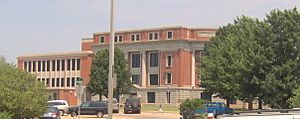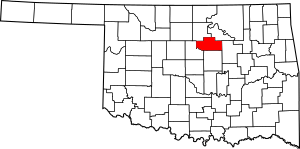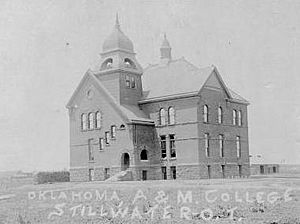Payne County, Oklahoma facts for kids
Quick facts for kids
Payne County
|
|||
|---|---|---|---|

Payne County Courthouse
|
|||
|
|||

Location within the U.S. state of Oklahoma
|
|||
 Oklahoma's location within the U.S. |
|||
| Country | |||
| State | |||
| Founded | May 2, 1890 | ||
| Named for | Capt. David L. Payne | ||
| Seat | Stillwater | ||
| Largest city | Stillwater | ||
| Area | |||
| • Total | 697 sq mi (1,810 km2) | ||
| • Land | 685 sq mi (1,770 km2) | ||
| • Water | 12 sq mi (30 km2) | ||
| Population
(2020)
|
|||
| • Total | 81,646 | ||
| • Density | 117.14/sq mi (45.23/km2) | ||
| Time zone | UTC−6 (Central) | ||
| • Summer (DST) | UTC−5 (CDT) | ||
| Congressional district | 3rd | ||
Payne County is a county in the state of Oklahoma. In 2020, about 81,646 people lived there. The main city and government center is Stillwater. The county was started in 1890. It is named after Captain David L. Payne, who was a leader of the "Boomers" settlers.
Payne County is part of the Stillwater, Oklahoma area. Many people who live here travel to work in the Oklahoma City metropolitan area.
Contents
History of Payne County
This county was officially created in 1890. It was called the Sixth County by the Oklahoma Organic Act. This act also decided that Stillwater would be the county seat. This was after a disagreement between Stillwater and Perkins. The land in the county was settled during the Land Run of 1889.
Between 1900 and 1902, the Eastern Oklahoma Railway built two train lines in Payne County. These lines were then used by the Atchison, Topeka and Santa Fe Railway. The train lines helped farmers get their crops to market.
In 2010, the Keystone-Cushing Pipeline was built through Payne County.
Geography and Nature
The county covers about 697 square miles. Most of this area, 685 square miles, is land. The rest, about 12 square miles, is water.
Payne County has rolling plains. Most of it is in the Sandstone Hills area. The western part is in the Red Bed plains. The county has two important lakes: Lake McMurtry and Lake Carl Blackwell. The Cimarron River and Stillwater Creek flow through most of the county.
How to Get Around
- OSU-Stillwater Community Transit
Main Roads
Airports
- KSWO - Stillwater Regional Airport: You can fly to Dallas from here with American Airlines.
- KCUH - Cushing Municipal Airport
Neighboring Counties
- Noble County (northwest)
- Pawnee County (northeast)
- Creek County (east)
- Lincoln County (south)
- Logan County (southwest)
People of Payne County
| Historical population | |||
|---|---|---|---|
| Census | Pop. | %± | |
| 1890 | 7,215 | — | |
| 1900 | 20,909 | 189.8% | |
| 1910 | 23,735 | 13.5% | |
| 1920 | 30,180 | 27.2% | |
| 1930 | 36,905 | 22.3% | |
| 1940 | 36,057 | −2.3% | |
| 1950 | 46,430 | 28.8% | |
| 1960 | 44,231 | −4.7% | |
| 1970 | 50,654 | 14.5% | |
| 1980 | 62,435 | 23.3% | |
| 1990 | 61,507 | −1.5% | |
| 2000 | 68,190 | 10.9% | |
| 2010 | 77,350 | 13.4% | |
| 2020 | 81,646 | 5.6% | |
| 2023 (est.) | 83,352 | 7.8% | |
| U.S. Decennial Census 1790–1960 1900–1990 1990–2000 2010–2019 |
|||
In 2000, there were 68,190 people living in Payne County. By 2020, the population grew to 81,646.
In 2021, the people living in Payne County were:
- 76.1% White (not Hispanic)
- 3.9% African American
- 5.7% Native American
- 4.3% Asian
- 0.1% Pacific Islander
- 6.0% people of two or more races
- 5% Hispanic or Latino (of any race)
In 2000, about 19.6% of the people were under 18 years old. The average age was 28 years.
Economy and Jobs
For over 50 years, farming was the main way people made money in Payne County. The most common crops were cotton, corn, and wheat.
During World War II, many students from Oklahoma A & M College left to join the military. To help the local economy, leaders worked to make the school a war training center. This led to many training programs. This experience showed leaders that they needed different types of jobs. They created a group to bring in factories and industrial jobs. This helped the county's population grow.
Education in Payne County

Here are some places for learning in Payne County:
- Oklahoma Department of Career and Technology Education
- Oklahoma State University-Stillwater
- Northern Oklahoma College
- Meridian Technology Center
Towns and Communities
Cities
- Cushing
- Drumright (mostly in Creek County)
- Perkins
- Stillwater (the county seat)
- Yale
Towns
- Glencoe
- Mulhall (mostly in Logan County)
- Orlando (partly in Logan County)
- Ripley
Other Communities
These are smaller places that are not officially cities or towns:
- Ingalls
- Mehan
- Quay (partly in Pawnee County)
- Oak Grove
- Vinco
- Yost Lake
Historic Places
Many places in Payne County are listed on the National Register of Historic Places. This means they are important for their history or architecture.
- James E. Berry House, Stillwater
- Campus Fire Station, Stillwater
- Citizens Bank Building (Stillwater, Oklahoma), Stillwater
- Cottonwood Community Center, Stillwater
- Cushing American Legion Building, Cushing
- Cushing Armory, Cushing
- William Frick House, Stillwater
- Hoke Building, Stillwater
- Hopkins Sandstone House and Farmstead, Ripley
- Irvings Castle, Ingalls
- Josephine Reifsnyder Lustron House, Stillwater
- Magruder Plots, Stillwater
- Murphy House, Stillwater
- Oklahoma A & M College Agronomy Barn and Seed House, Stillwater
- Old Central, Oklahoma State University, Stillwater
- Payne County Courthouse, Stillwater
- Perkins Downtown Historic District, Perkins
- Pleasant Valley School, Stillwater
- Selph Building, Stillwater
- Stillwater Santa Fe Depot, Stillwater
- Jim Thorpe House, Yale
- Walker Building, Stillwater
Another important landmark is the Allen Williamson Bridge. This bridge near Ripley is named after Oklahoma Representative Allen Williamson.
See also
 In Spanish: Condado de Payne para niños
In Spanish: Condado de Payne para niños




